翻译层次词语层
- 格式:pptx
- 大小:146.41 KB
- 文档页数:35
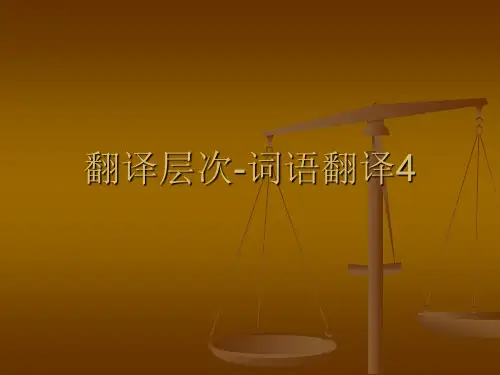
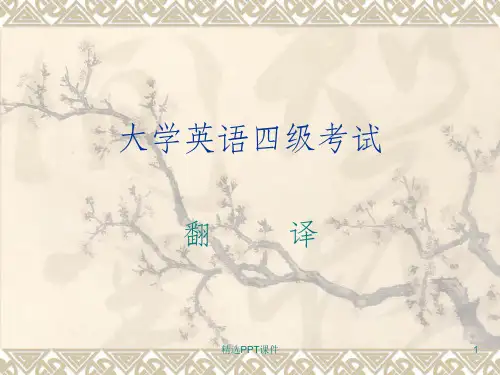
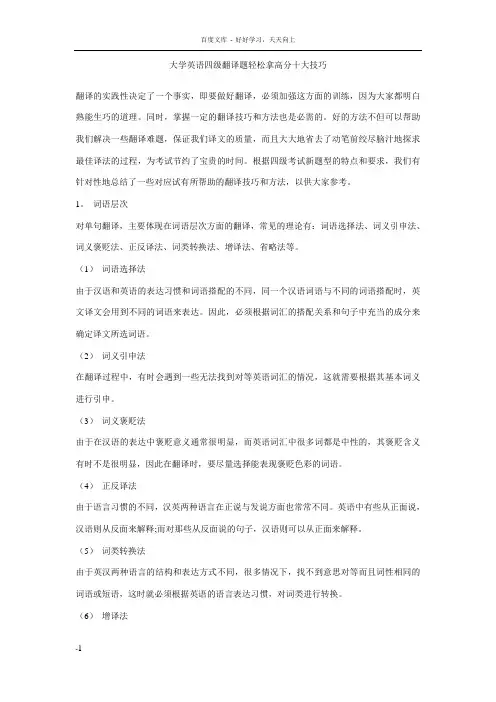
大学英语四级翻译题轻松拿高分十大技巧-翻译的实践性决定了一个事实,即要做好翻译,必须加强这方面的训练,因为大家都明白熟能生巧的道理。
同时,掌握一定的翻译技巧和方法也是必需的。
好的方法不但可以帮助我们解决一些翻译难题,保证我们译文的质量,而且大大地省去了动笔前绞尽脑汁地探求最佳译法的过程,为考试节约了宝贵的时间。
根据四级考试新题型的特点和要求,我们有针对性地总结了一些对应试有所帮助的翻译技巧和方法,以供大家参考。
1。
词语层次对单句翻译,主要体现在词语层次方面的翻译,常见的理论有:词语选择法、词义引申法、词义褒贬法、正反译法、词类转换法、增译法、省略法等。
(1)词语选择法由于汉语和英语的表达习惯和词语搭配的不同,同一个汉语词语与不同的词语搭配时,英文译文会用到不同的词语来表达。
因此,必须根据词汇的搭配关系和句子中充当的成分来确定译文所选词语。
(2)词义引申法在翻译过程中,有时会遇到一些无法找到对等英语词汇的情况,这就需要根据其基本词义进行引申。
(3)词义褒贬法由于在汉语的表达中褒贬意义通常很明显,而英语词汇中很多词都是中性的,其褒贬含义有时不是很明显,因此在翻译时,要尽量选择能表现褒贬色彩的词语。
(4)正反译法由于语言习惯的不同,汉英两种语言在正说与发说方面也常常不同。
英语中有些从正面说,汉语则从反面来解释;而对那些从反面说的句子,汉语则可以从正面来解释。
(5)词类转换法由于英汉两种语言的结构和表达方式不同,很多情况下,找不到意思对等而且词性相同的词语或短语,这时就必须根据英语的语言表达习惯,对词类进行转换。
(6)增译法在翻译时,有时为了使所翻译的译文更符合英语的表达习惯而增加一些必要的词语。
指根据英汉两种语言不同的思维方式、语言习惯和表达方式,在翻译时增添一些词、短句或句子,以便更准确地表达出原文所包含的意义。
这种方式多半用在汉译英里。
汉语无主句较多,而英语句子一般都要有主语,所以在翻译汉语无主句的时候,除了少数可用英语无主句、被动语态或There be结构来翻译以外,一般都要根据语境补出主语,使句子完整。
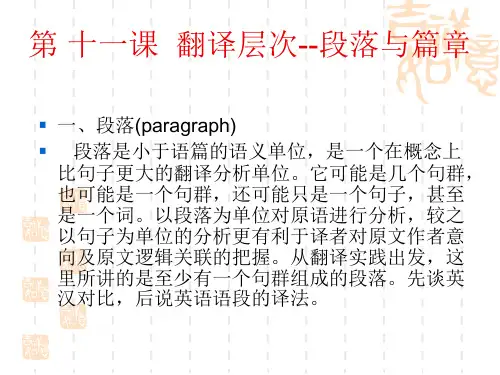
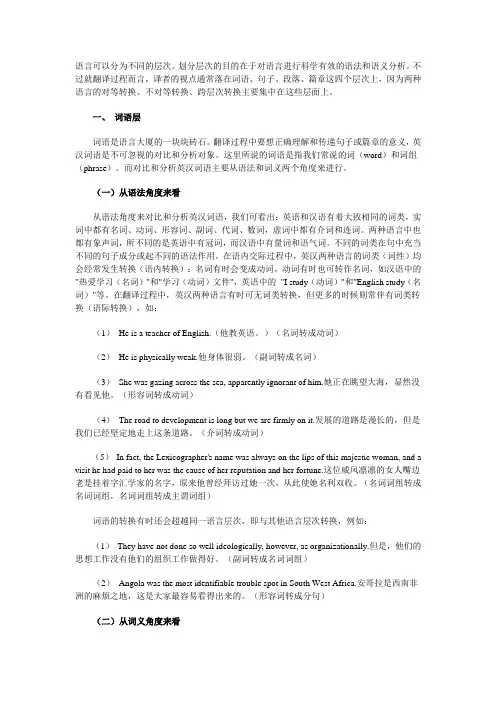
语言可以分为不同的层次。
划分层次的目的在于对语言进行科学有效的语法和语义分析。
不过就翻译过程而言,译者的视点通常落在词语、句子、段落、篇章这四个层次上,因为两种语言的对等转换、不对等转换、跨层次转换主要集中在这些层面上。
一、词语层词语是语言大厦的一块块砖石。
翻译过程中要想正确理解和传递句子或篇章的意义,英汉词语是不可忽视的对比和分析对象。
这里所说的词语是指我们常说的词(word)和词组(phrase)。
而对比和分析英汉词语主要从语法和词义两个角度来进行。
(一)从语法角度来看从语法角度来对比和分析英汉词语,我们可看出:英语和汉语有着大致相同的词类,实词中都有名词、动词、形容词、副词、代词、数词,虚词中都有介词和连词。
两种语言中也都有象声词,所不同的是英语中有冠词,而汉语中有量词和语气词。
不同的词类在句中充当不同的句子成分或起不同的语法作用。
在语内交际过程中,英汉两种语言的词类(词性)均会经常发生转换(语内转换):名词有时会变成动词,动词有时也可转作名词,如汉语中的"热爱学习(名词)"和"学习(动词)文件",英语中的"I study(动词)"和"English study(名词)"等。
在翻译过程中,英汉两种语言有时可无词类转换,但更多的时候则常伴有词类转换(语际转换),如:(1)He is a teacher of English.(他教英语。
)(名词转成动词)(2)He is physically weak.他身体很弱。
(副词转成名词)(3)She was gazing across the sea, apparently ignorant of him.她正在眺望大海,显然没有看见他。
(形容词转成动词)(4)The road to development is long but we are firmly on it.发展的道路是漫长的,但是我们已经坚定地走上这条道路。
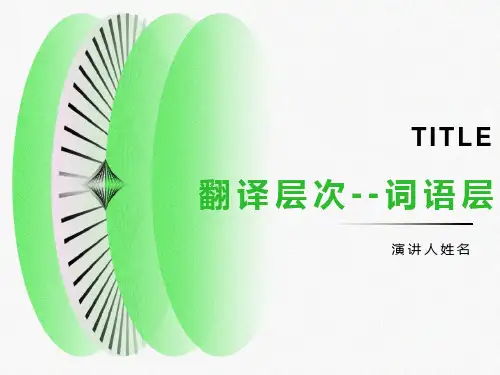
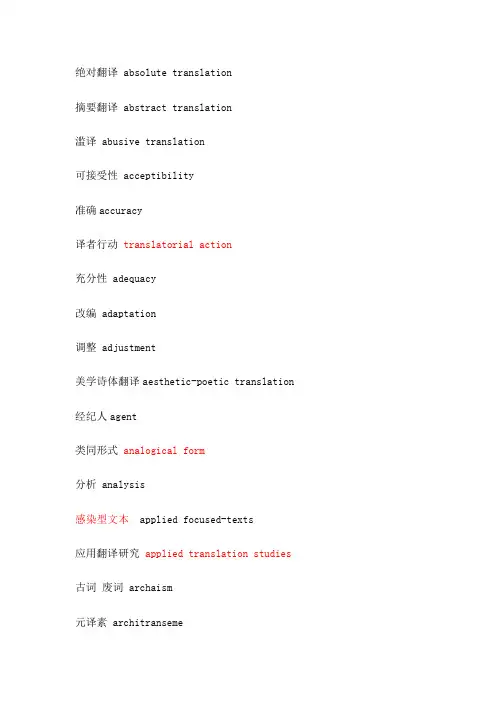
绝对翻译 absolute translation摘要翻译 abstract translation滥译 abusive translation可接受性 acceptibility准确accuracy译者行动translatorial action充分性 adequacy改编 adaptation调整 adjustment美学诗体翻译aesthetic-poetic translation 经纪人agent类同形式analogical form分析 analysis感染型文本 applied focused-texts应用翻译研究applied translation studies 古词废词 archaism元译素 architranseme关于范围的翻译理论area-restricted theories of translation 听觉媒介型文本 audio-medial texts委托 commission自动翻译 automatic translation自立幅度 autonomy spectrum自译 autotranslation逆转换 back-transformation关于范围的翻译理论back-translation双边传译 bilateral interpreting双语语料库bilingual corporal双文本bi-text空位 blank spaces无韵体翻译 blank verse translation借用 borrowing仿造 calque机助翻译 MAT范畴转换 category shift词类转换 class shift贴近翻译 close translation连贯 coherence委托 commission传意负荷 communication load传意翻译 communicative translation社群传译 community interpreting对换 commutation可比语料库 comparable corpora补偿compensation能力 competence成分分析componential analysis机器辅助翻译MAT一致性concordance会议传译conference interpreting接续传译consecutive interpreting建构性翻译常规 constitutive translational conventions派生内容的形式content-derivative form重内容文本 content-focused texts语境一致contextual consistency受控语言 controlled language常规 conventions语料库 corpora可修正性 correctability对应 correspondence法庭传译court interpreting隐型翻译covert translation跨时翻译理论 cross-temporal theories of translation 文化途径 cultural approach文化借用 cultural borrowing文化替换 cultural substitution文化翻译 cultural translation文化移植 cultural transplantation文化置换 cultural transposition区分度degree of differentiation翻译定义definitions of translation描写翻译研究 descriptive translation studies图表翻译diagrammatic translation对话传译 dialogue interpreting说教忠信didactic fidelity直接翻译 direct translation翻译方向 direction of translation消解歧义disambiguation关于话语类型的翻译理论discourse type-restricted theories of translation文献型翻译 documentary translation归化翻译 domesticating translation配音 dubbing动态性 dynamics动态对等 dynamic equivalence动态忠信 dynamic fidelity用功模式 effort models借用 borrowing种族学翻译enthnographic translation翻译的种族语言学模式 enthnolinguistic model of translation 非目标接受者 excluded receiver诠释性翻译 exegetic translation诠释忠信 exegetical fidelity异国情调 exoticism期望规范 expectancy norms明示 explicitation表情型文本 expressive texts外部转移external transfer外来形式 extraneous form忠实faithfulness假朋友false friends假翻译fictitious translation贴近 coherence异化翻译 foreignizing translation派生形式的形式 form-derivative forms重形式文本 content-focused texts形式对应 formal correspondence形式对等 formal equivalence前向转换 forward transformation自由译 free translation全文翻译 total translation功能取向翻译研究 function-oriented translation studies 功能对等 function equivalence空隙 gaps宽泛化 generalization宽泛化翻译generalizing translation要旨翻译gist translation释词翻译 gloss translation成功 success目的语 goal languages语法分析 grammatical analysis语法置换 grammatical transposition字形翻译graphological translation诠释步骤 hermeneutic motion对应层级hierarchy of correspondences历史忠信historical fidelity同音翻译homophonic translation音素翻译phonemic translation横向翻译 horizontal translation超额信息 hyperinformation同一性identity地道翻译idomatic translation地道性idomaticity不确定性indeterminacy间接翻译 indirect translation翻译即产业过程 translation as industrial process 信息负荷 information load信息提供 information offer信息型文本informative texts初始规范initial norms工具型翻译 instrumental translation整合翻译 integral translation跨文化合作intercultural cooperation中间语言 interlanguage隔行翻译interlineal translation逐行翻译interlinear translation语际语言 interlingua语际翻译interlingual translation中介翻译 intermediate translation内部转移 internal transfer解释 interpretation传译 interpreting翻译释意理论 interpretive theory of translation 符际翻译intersemiotic translation互时翻译intertemporal translation 语内翻译intralingual translation 系统内转换 intra-system shift不变量 invariant不变性 invariance逆向翻译inverse translation隐形 invisibility核心 kernel关键词翻译 keyword translation贴近 coherence可核实性 verifiability可修正性 correctability空缺 voids层次转换 level shift词汇翻译 lexical translation联络传译 liaison interpreting普遍语言 lingua universalis语言学途径linguistic approach语言对等 linguistic equivalence语言翻译linguistic translation语言创造性翻译linguistically creative translation 字面翻译 literal translation直译法 literalism借译 load translation原素logeme逻各斯 logos低地国家学派 low countries groups忠诚 loyalty机助翻译MAT机器翻译machine translation操纵manipulation操纵学派manipulation school图谱mapping矩阵规范matricial norms中继翻译 mediated translation中介语言 mediating language词译 metaphrase元诗metapoem元文本 metatext韵律翻译metrical translation模仿形式mimetic form最小最大原则 minimax principle 小众化 minoritizing translation 调整 modification调适 modulation语义消歧 semantic disambiguation 多语语料库multilingual corpora 多媒介型文本multi-medial texts 多阶段翻译 multiple-stage texts 变异 mutation自然性 naturalness必要区分度 necessary degree of differentiation 负面转换negative shift无遗留原则no leftover principle规范 norms必要对等语 obligatory equivalents曲径翻译 oblique translation观察型接受者observational receiver信息提供 information offer操作模式operational models操作规范 operational norms运作型文本 operative texts可换对等语 optional equivalents有机形式organic form重合翻译 overlapping translation显型翻译 overt translation范式对等 paradigmatic equivalence平行语料库 parallel corpora释词 paraphrase局部翻译理论 partial theories of translation 部分重合翻译partially-overlapping translation 参与型接受者particularizing receiver具体化翻译 particularizing translation赞助 patronage运用 performance音素翻译phonemic translation音位翻译phonological translation中枢语言 pivot language译诗为文poetry into prose争辩式翻译polemical translation多元系统理论 polysystem theory译后编辑 post-editing译前编辑pre-editing语用途径 pragmatic approach精确度 degree of precision预先规范preliminary norms规定翻译研究 prescriptive theories of translation首级翻译 primary translation关于问题的翻译理论 problem-restrained theories of translation 成品取向翻译研究 product-oriented studies of translation过程取向翻译研究 process-oriented studies of translation专业规范 professional norms散文翻译 prose translation前瞻式翻译prospective translation抗议 protest原型文本 prototext伪翻译 psedotranslation公共服务传译 public service interpreting纯语言 pure language原始翻译 radical translation级阶受限翻译rank-bound translation关于级阶的翻译理论 rank-restricted theories of translation读者取向机器翻译 reader-oriented machine translation 独有特征 realia接受语 receptor language重构式翻译translation with reconstructions冗余 redundancy折射refraction规约性翻译常规 regulative translational conventions 转接传译 relay interpreting知识库要素repertoreme变换措词rephrasing阻抗 resistancy受限翻译 restricted translation重组 restructuring转译 retranslation后瞻式翻译retrospective translation换词rewording换声 revoicing重写 rewrtiting韵体翻译rhymed translation翻译科学 science of translation目的论scopos theory二级翻译second-hand translation二手翻译secondary translation选译 selective translation自译 self translation语义消歧 semantic disambiguation语义翻译 semantic translation语义空缺 semantic voids意义理论theory of sense意对意翻译 sense-for-sense translation 序列翻译 serial translation服务翻译 service translation转换shifts视译 sight translation手语传译signed language translation同声传译simultaneous interpreting源语 source language源文本source text源文本取向翻译研究source text-oriented translation studies 具体化specification结构转换 structure shift文体对等 stylistic equivalence子语言sublanguage配字幕 substituting成功 success超额翻译 overtranslation组合对等syntagmatic equivalence系统system有声思维记录think-aloud protocols目标语 target language目标文本 target texts目标文本取向翻译研究 target text-oriented translation studies术语库 term banks术语 terminology文本类型学text typology文本素texteme关于文本类型的翻译理论text type-restricted theories of translation文本对等 textual equivalence文本规范 textual norms理论翻译研究theoretical translation studies意义理论theory of sense增量翻译 thick translation有声思维记录 think aloud protocols第三语码third code第三语言third language关于时域的翻译理论 temporal-restricted theories of translation完全翻译 total translation巴别塔 tower of babel注音 transcription译素 transeme转移 transfer转移取向翻译研究 transfer-oriented translation studies 迁移 transference转换 transformation可译性 translatability笔译 translation翻译与博弈理论 translation and the theory of games翻译即抉择translation as decision-making翻译即产业过程 translation as industrial process翻译对等translation equivalence翻译研究translation studies翻译理论translation theory翻译单位 translation unit翻译普遍特征translation universals重构式翻译 translation with reconstructions 翻译对等 translation equivalence翻译体 translationese翻译学translatology译者行动translatorial action音译 transliteration符际转化 transmutation置换 transposition不受限翻译 unbounded translation欠额翻译 undertranslation翻译单位 translation unit单位转换 unit shift不可译性 untranslatability词语一致verbal consistency可核实性 correctability改本改译 version纵向翻译vertical translation空缺 voids耳语传译whispered interpreting词对词翻译 word- for-word translation作者取向翻译机器 reader-oriented machine translation。
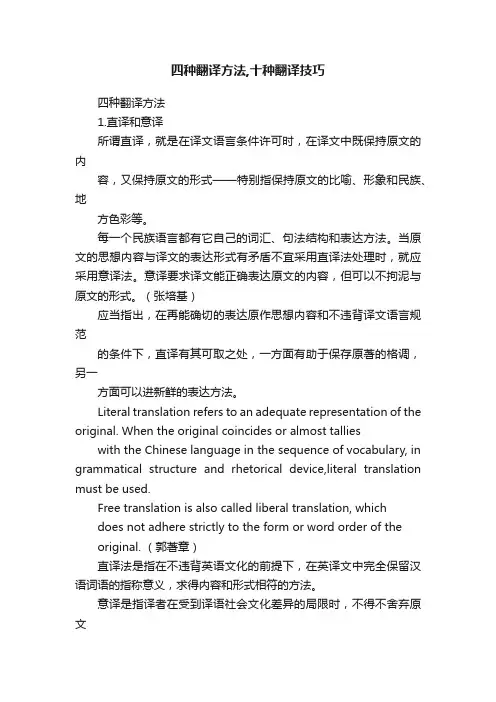
四种翻译方法,十种翻译技巧四种翻译方法1.直译和意译所谓直译,就是在译文语言条件许可时,在译文中既保持原文的内容,又保持原文的形式——特别指保持原文的比喻、形象和民族、地方色彩等。
每一个民族语言都有它自己的词汇、句法结构和表达方法。
当原文的思想内容与译文的表达形式有矛盾不宜采用直译法处理时,就应采用意译法。
意译要求译文能正确表达原文的内容,但可以不拘泥与原文的形式。
(张培基)应当指出,在再能确切的表达原作思想内容和不违背译文语言规范的条件下,直译有其可取之处,一方面有助于保存原著的格调,另一方面可以进新鲜的表达方法。
Literal translation refers to an adequate representation of the original. When the original coincides or almost tallieswith the Chinese language in the sequence of vocabulary, in grammatical structure and rhetorical device,literal translation must be used.Free translation is also called liberal translation, whichdoes not adhere strictly to the form or word order of theoriginal. (郭著章)直译法是指在不违背英语文化的前提下,在英译文中完全保留汉语词语的指称意义,求得内容和形式相符的方法。
意译是指译者在受到译语社会文化差异的局限时,不得不舍弃原文的字面意义,以求疑问与原文的内容相符和主要语言功能的相似。
(陈宏薇)简单地说,直译指在译文中采用原作的的表达方法,句子结构与原句相似,但也不排除在短语层次进行某些调整。
意译指在译文中舍弃原作的表达方法,另觅同意等效的表达方法,或指对原作的句子结构进行较大的变化或调整。
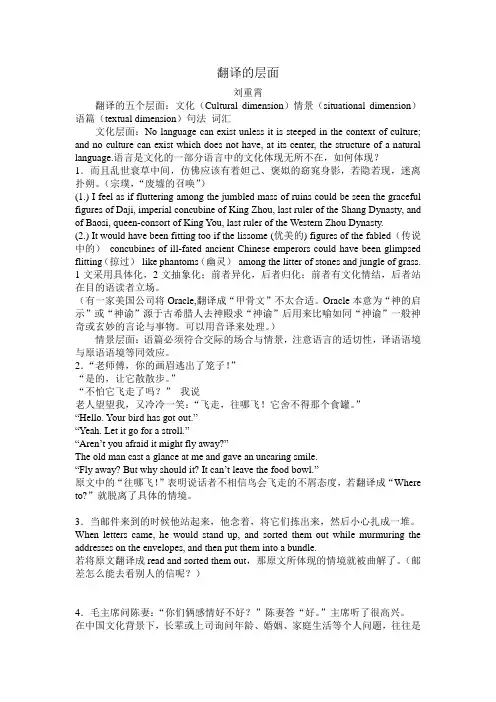
翻译的层面刘重霄翻译的五个层面:文化(Cultural dimension)情景(situational dimension)语篇(textual dimension)句法词汇文化层面:No language can exist unless it is steeped in the context of culture; and no culture can exist which does not have, at its center, the structure of a natural language.语言是文化的一部分语言中的文化体现无所不在,如何体现?1.而且乱世衰草中间,仿佛应该有着妲己、褒姒的窈窕身影,若隐若现,迷离扑朔。
(宗璞,“废墟的召唤”)(1.) I feel as if fluttering among the jumbled mass of ruins could be seen the graceful figures of Daji, imperial concubine of King Zhou, last ruler of the Shang Dynasty, and of Baosi, queen-consort of King You, last ruler of the Western Zhou Dynasty. (2.) It would have been fitting too if the lissome (优美的) figures of the fabled(传说中的)concubines of ill-fated ancient Chinese emperors could have been glimpsed flitting(掠过)like phantoms(幽灵)among the litter of stones and jungle of grass. 1文采用具体化,2文抽象化;前者异化,后者归化;前者有文化情结,后者站在目的语读者立场。
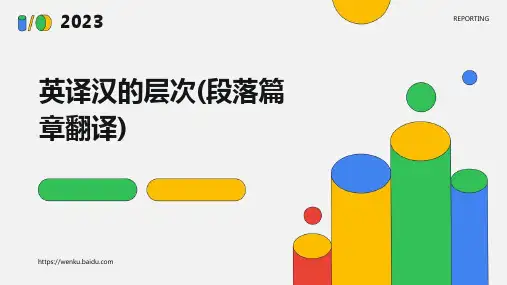
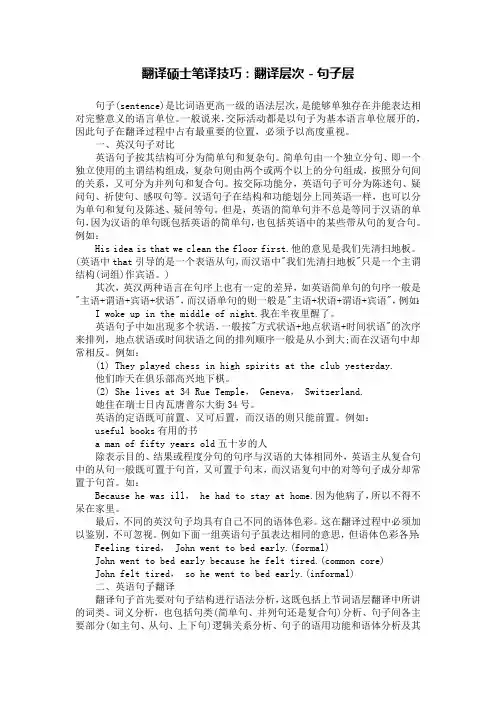
翻译硕士笔译技巧:翻译层次-句子层 句子(sentence)是比词语更高一级的语法层次,是能够单独存在并能表达相对完整意义的语言单位。
一般说来,交际活动都是以句子为基本语言单位展开的,因此句子在翻译过程中占有最重要的位置,必须予以高度重视。
一、英汉句子对比 英语句子按其结构可分为简单句和复杂句。
简单句由一个独立分句、即一个独立使用的主谓结构组成,复杂句则由两个或两个以上的分句组成,按照分句间的关系,又可分为并列句和复合句。
按交际功能分,英语句子可分为陈述句、疑问句、祈使句、感叹句等。
汉语句子在结构和功能划分上同英语一样,也可以分为单句和复句及陈述、疑问等句。
但是,英语的简单句并不总是等同于汉语的单句,因为汉语的单句既包括英语的简单句,也包括英语中的某些带从句的复合句。
例如: His idea is that we clean the floor first.他的意见是我们先清扫地板。
(英语中that 引导的是一个表语从句,而汉语中"我们先清扫地板"只是一个主谓结构(词组)作宾语。
) 其次,英汉两种语言在句序上也有一定的差异,如英语简单句的句序一般是"主语+谓语+宾语+状语",而汉语单句的则一般是"主语+状语+谓语+宾语",例如: I woke up in the middle of night.我在半夜里醒了。
英语句子中如出现多个状语,一般按"方式状语+地点状语+时间状语"的次序来排列,地点状语或时间状语之间的排列顺序一般是从小到大;而在汉语句中却常相反。
例如: (1) They played chess in high spirits at the club yesterday. 他们昨天在俱乐部高兴地下棋。
(2) She lives at 34 Rue Temple, Geneva, Switzerland. 她住在瑞士日内瓦唐普尔大街34号。
翻译技巧和翻译方法翻译方法:methods of translation1.直译literal translation2.意译free translation3.异化alienation4.归化domestication1. 直译(literal translation)指在翻译过程中按原文逐字逐句一对一的翻译。
人们关心的是语言层面的技术处理问题,即如何在保持原语形式的同时,不让其意义失真。
e.g.one country, two systems 一国两制The three religions and the nine schools of thought三教九流2. 意译(free translation;paraphrase)是指根据原文的大意来翻译,不作逐字逐句的翻译(区别于“直译”)。
通常在翻译句子或词组(或更大的意群)时使用较多,意译主要在原语与译语体现巨大文化差异的情况下得以应用.从跨文化语言交际和文化交流的角度来看,意译强调的是译语文化体系和原语文化体系的相对独立性。
e.g.Don’t cross the bridge till you get to it.不必过早地担心。
(不必自寻烦恼)Do you see any green in my eye?你以为我是好欺骗的吗?Don’t lock the stable door after the horse has been stolen.精选文库意译:亡羊补牢。
直译和意译的区别1. It’ s a Smoke Free Area.直译:它是个自由吸烟区。
意译:它是个无烟区。
2. Shakespeare put his hometown on the map.直译:莎士比亚把他的家乡放在了地图上。
意译:莎土比亚使他的家乡声名远扬。
3. John would not come out of his shell and talk to others at theparty.直译:晚会上,约翰不愿从壳里钻出来与其他人说话。
第一节翻译及其概念1.翻译翻译是语言活动的重要组成部分。
指把一种语言或语言变体的内容变为另一种语言或语言变体的过程或结果;或者可以说,把用一种语言材料构成的文本用另一种语言准确而完整地再现出来。
方梦之——《译学词典》(2004)中“翻译”一词有五个义项:(1)翻译过程;(2)翻译行为;(3)翻译者;(4)译文或译语;(5)翻译工作(专业)。
综合以上观点认为,“翻译”既可以作为过程,也可以作为结果和职业,同时它还兼指口译和笔译。
然而,通常翻译领域的学者给翻译下定义时,指的是整个抽象的概念,即包括过程和结果,而不包括职业。
定义:约翰·卡特福德(Catford 1965)翻译是用一种等值的语言(译语)的文本材料去替换另一种语言的文本材料(等值替换)约翰逊博士(Dr. Samuel Johnson)翻译就是将一种语言换成另一种语言,保持原文意思不变(保持)尤金·奈达(Eugene A. Nida)翻译就是用接受语言复制出与原语信息最接近的自然等值体----首先是就意义而言,其次是就风格而言。
该定义体现了奈达的对等观。
奈达的归化理论主张关注目标语读者的阅读和审美习惯。
然而由于民族文化差异,语义和语体的对等很难实现。
(复制自然等值体)杜波斯(Dubois)翻译是把第一种语言(源语)语篇所表达的东西用第二种语言(目的语)重新表达出来,尽量保持语义与语体方面的等值。
(重新表达保持等值)罗曼·雅各布森(Roman Jakobson)翻译是用另一种语言解释原文的语言符号该定义从符号学的角度界定翻译,然而对翻译的目标、标准等未做深入阐释。
(解释)图瑞(Toury)翻译是在目标语文化的框架内把原文用目标语呈现出来该定义提出了目标语文化,使翻译研究的范畴从语言层面向文化层面拓展。
(目标语文化)哈提姆和梅森(Basil Hatim & Ian Mason)翻译是一种在某社会语境中发生的交际过程。
翻译的四个层次在阅读和分析原文以后,关键的问题就是如何忠实地表达原文的意思了。
按照英国翻译理论家纽马克(1988)的观点,在表达的过程中,译者必须在四个层次上对原文和译文负责。
即文本层次,所指层次,粘着层次和自然层次。
文本层次指原文的字面意义。
这是译者首先关注的层次,因为任何翻译都不能离开原文。
原文是翻译活动的起点,也是终点。
所谓译者必须对原文负责,在某种意义上说,就是对原文的字面意义负责。
人们常说,同一个意思,可以有几种不同的表达方法,这里所说的“表达方法”指的就是字面意义。
这种说法固然有一定的道理,但是我们还应该看到原文作者之所以用这种而不是那种表达方法来表示某种意思,是有一定道理的。
换句话说,这两种表达方法还是有一定区别的。
例如,同一句话,用主动语态还是被动语态。
直接引语还是间接引语,有时候差别是很大的。
词汇的选择也是如此。
在英语和汉语中,大多数词汇都有同义词或近义词。
在一定的语境中,原文作者最后采纳的那个词,和它的同义词也肯定是有区别的。
因此,我们在翻译时,不妨想一想:原文作者为什么用某种结构或某个特定的词而没有用其他相近的结构或词?这对理解和表达都是非常重要的。
要忠实原文,既不能把原文作者没有说的或不想说的说出来,也不能把原文中的结构或词汇随便用相近的结构或同义词换掉。
不然的话,只抓住原文的大意,便信马由缰,难免会离题太远。
当然,由于英汉两种语言分属印欧语系则和汉藏语系,且受到各自国家的文化影响甚深,在语音、语法和词汇各方面都有著非常大的差别。
如果死扣原文,全然按原文的字面意义逐字译者,就可能将产生不合乎细读语习惯的,甚至错误的句子去。
在文本层次上,译者更须要把握住不好原文的意思。
有时候,原文的字面意义并不是很确切。
译者必须借由这层文字的迷雾,看清楚真实的画面,用细读语文字把它们描绘出来。
这时,由于两种语言的差异,细读语的文字和原文就可能会存有一定的距离。
在汉译英时,我们常常以为自己在认知上不能出来问题,但事实并非如此。